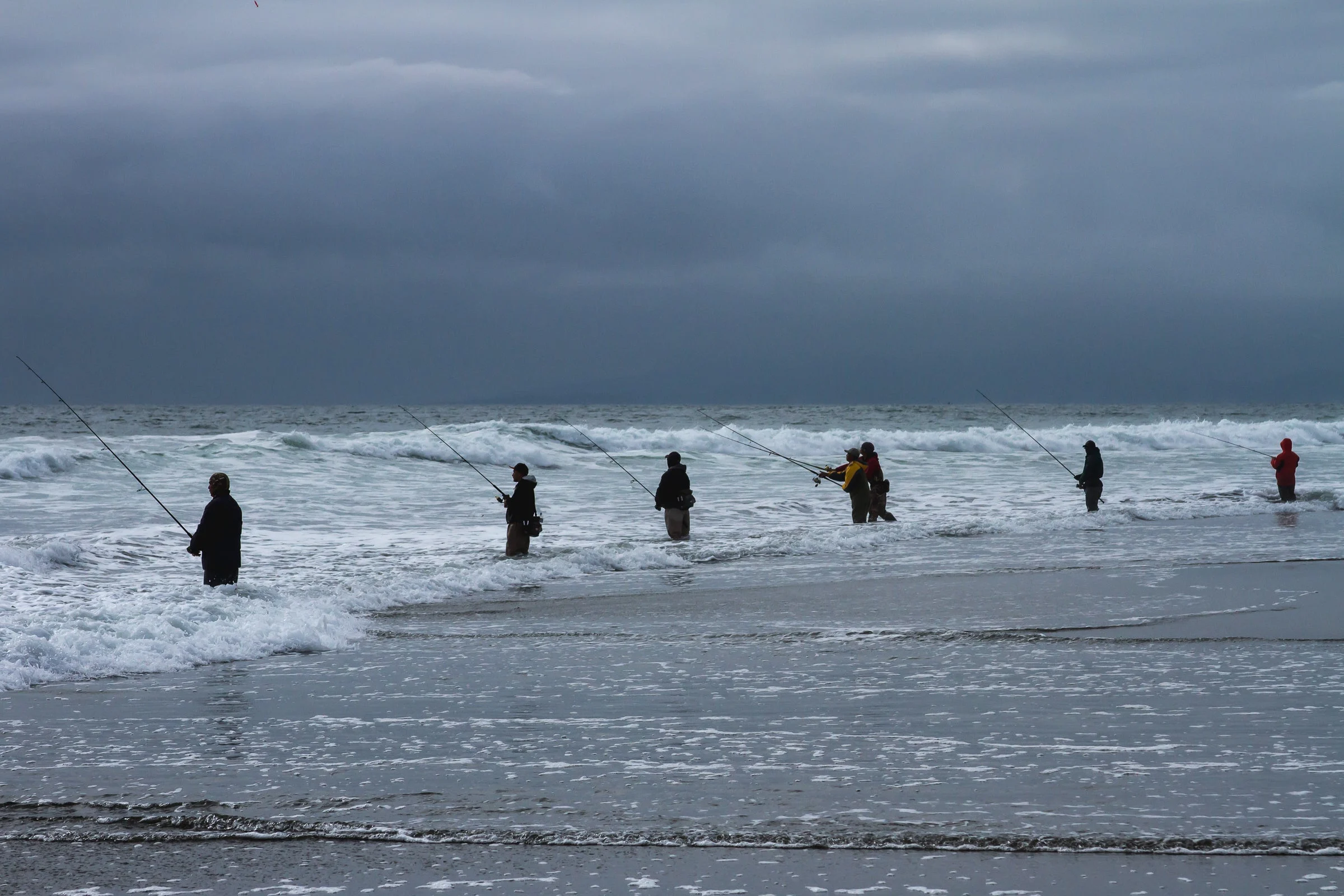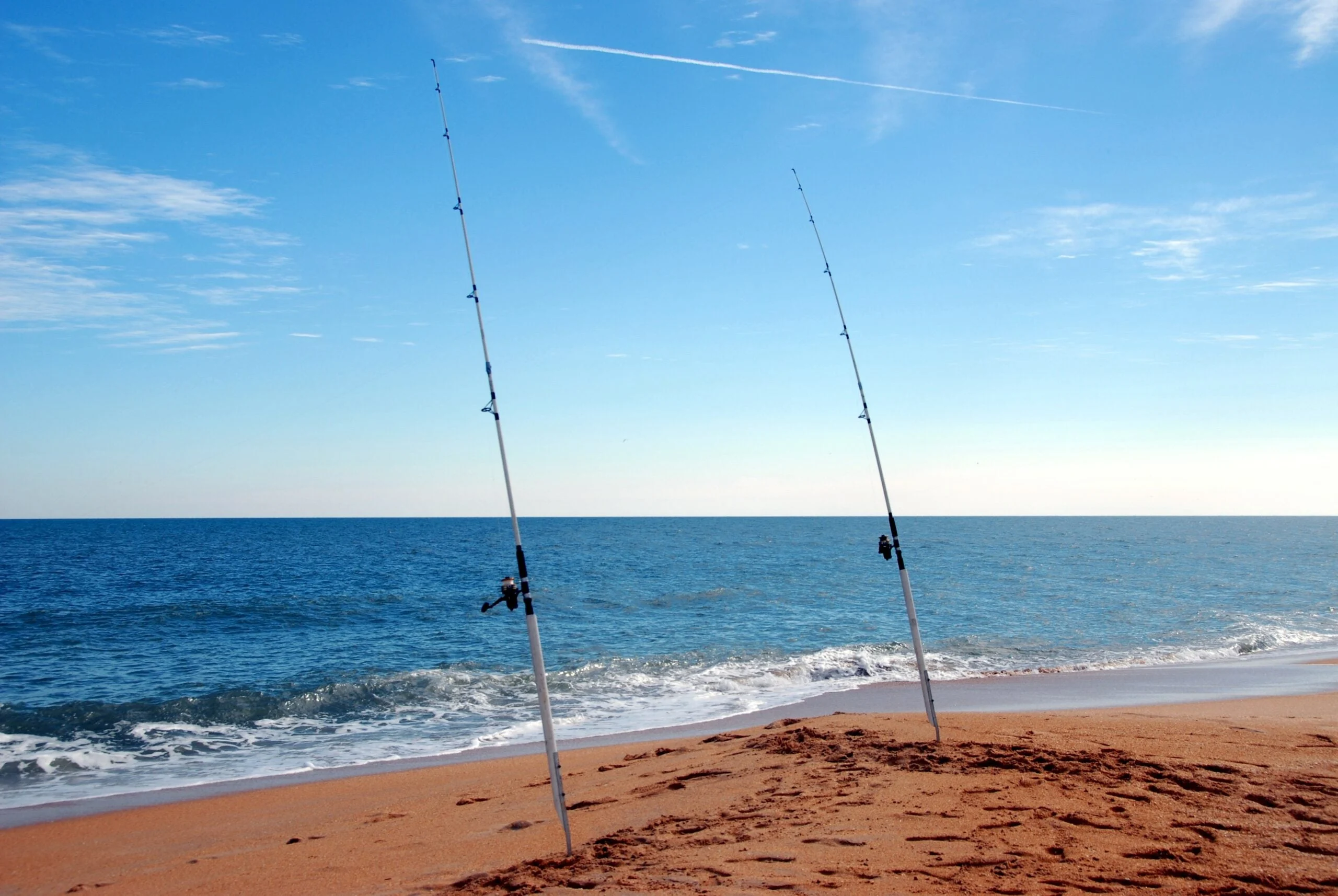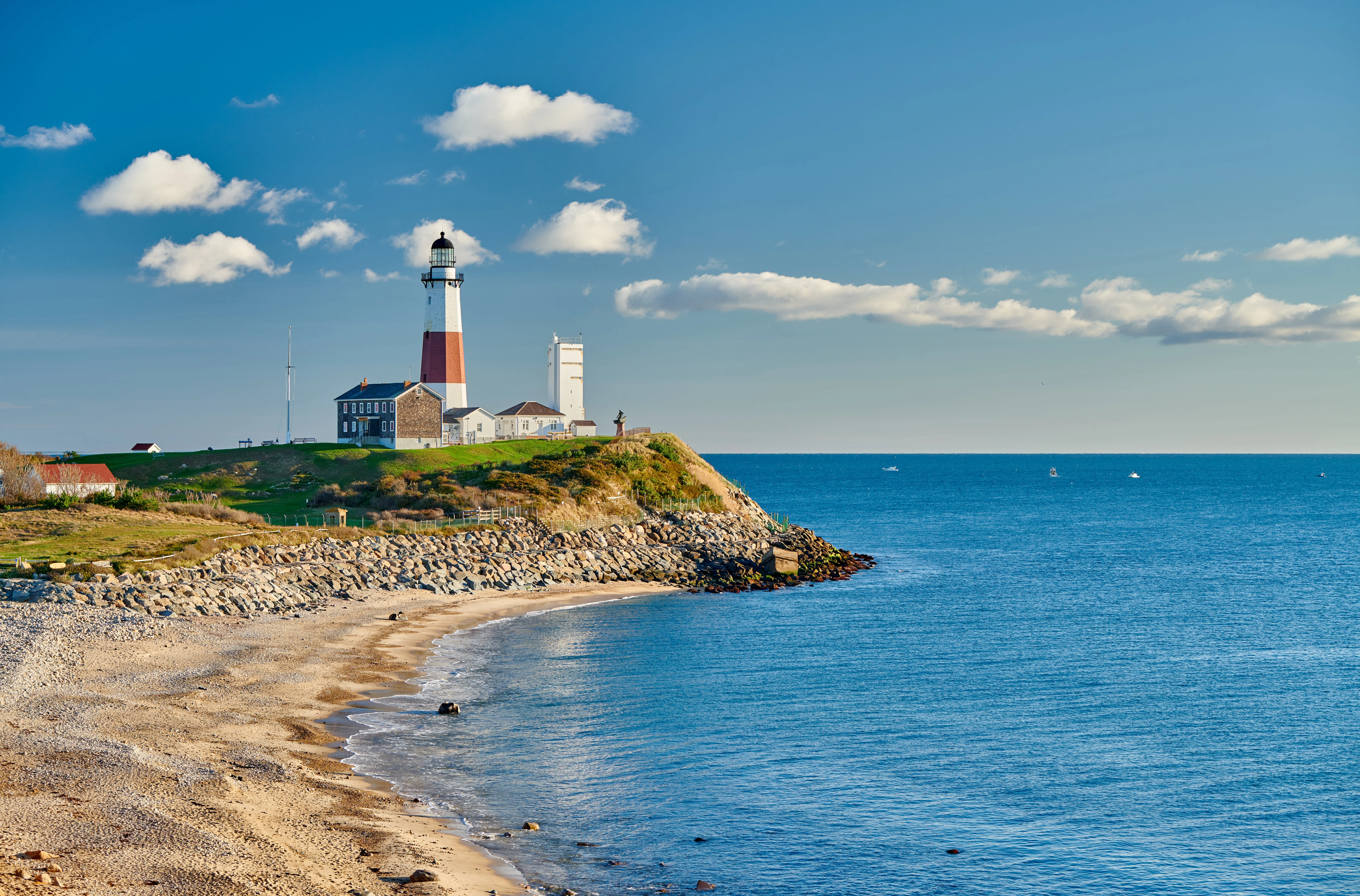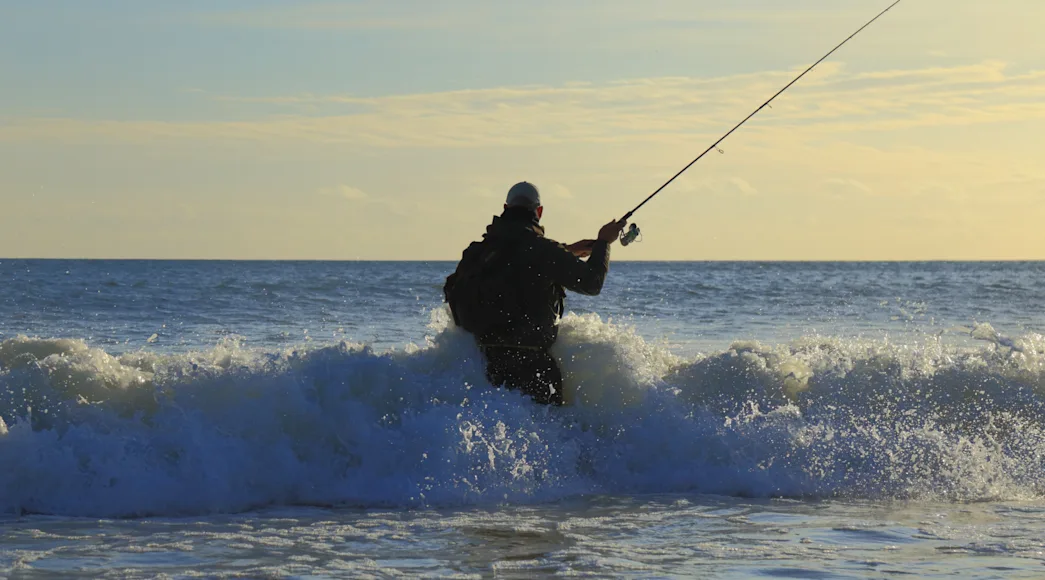Standing on the shore of a big lake or reservoir with a rod in your hand can be daunting. Still, the fish within that body of water are confined. The same can’t be said of the Atlantic Ocean. Catching a fish with your feet planted on the sand is one of angling’s biggest challenges, but when you’re successful, it’s also extremely rewarding. Brute fighters like bluefish, redfish, and striped bass have been pulling surf fishing anglers to the beaches from Florida to Maine for decades, and despite having better gear and intel than surf casters from bygone eras, connecting with these fish in the waves still takes patience and dedication.
That should not deter you, however, from getting into surf fishing. Over the years I’ve found that taking the initial leap is the most difficult part for many people, as the task just seems too overwhelming. It’s not. With a basic understanding of the tools you need and some insight into what to look for and when to hit the sand, you’ll be beaching your first fish in no time. Here’s a basic breakdown of what you need to know to get started surf fishing for blues, stripers, and reds—and I promise it’ll only take catching one fish to give you the drive to become a true surf “sharpie.”
Table of Contents
How to Surf Cast
How to Read the Beach
Understanding Weather and Tides
Essential Gear for Surf Fishing
Lures vs Bait
When to Go Surf Fishing
Top 5 Surf Fishing Hot Spots
How to Surf Cast

You can fish the surf with any rod and reel you’d like, but there’s a good reason why 10 feet is considered by many to be the most versatile rod length for delivering both lures and bait. (Check out our roundup of the best surf fishing rods.) For starters, length equals distance, and distance matters on the beach. Though how far you need to cast can vary by species, location, and season, most of the time it’s beneficial to be able to launch a bait or lure as far as possible. This is because species like striped bass and redfish feed on the back sides of the breaking waves where the water is a bit deeper, especially during low tide periods.
Distance aside, a quality 10-foot surf rod will also provide the strength and stamina to deliver the goods. It’s not uncommon to need a 5- to 8-ounce weight to keep your bait in place on the bottom, and a lighter rod simply wouldn’t have the backbone and proper flex to launch a sinker that heavy. Likewise, a beefier rod will allow you to really fire lighter lures and jigs with enough force to achieve the distance you need. With that in mind, I often see anglers on the beach holding back when they cast. Surf rods are designed to take abuse, and if you watch seasoned pros, they’ll cast so hard and fast you can hear the rod slice through the air and feel the wind in its wake. If you coddle your surf rod and hesitate to give your casts some oomph, it will cost you fish in the long game.
Regardless of whether you’re casting a lure or a surf fishing rig, you want to stand side to the surf with your legs apart for stability, keeping your toes pointed up or down the beach, not directly at the waves. Make sure your lure or rig is dangling 2 to 3 feet from the end of the rod tip before drawing the rod back over your shoulder. As you whip it forward, rotate your hips toward the waves, following through as you would when swinging a golf club. Keep the rod pointed at the lure or rig as it flies through the air so the line comes off the spool smoothly and easily with as little resistance as possible. Maintain this rod position until your offering splashes down.
How to Read the Beach
Nothing intimidates novice surf fishing anglers more than figuring out where to cast. I certainly understand. Oceans are vast and make you feel small. Even when you’ve been surf casting for years, there’s no guarantee the fish will be feeding in the same place they were yesterday or a week ago. The best advice I can give to help quell that intimidation is to think of the game more like deer hunting than fishing.
Look for Fish “Highways”
You pick a spot based on where you think fish might come through, not where you think they live, as you would in a lake or river. Bluefish, stripers, and redfish rarely spend very long in any given area within the surf line, rather they move through with the tide or stick around only when a food source is available in that spot. The bottom line is that fish in the surf are always on the move. The best you can do is decipher which areas would more likely be a part of the “highway” they’ll travel. By doing so—and accepting that not every outing will be a win—you’ll see seasonal patterns develop, and little by little, you’ll be able to draw a tighter and tighter bead on the most likely areas to see action based on the tide, weather, water temperature, and time of year. Still, you need a starting point, and that’s achieved by understanding the basics of reading waves.
Understanding Waves
Waves form as tidal-, wind-, or current-driven swells roll into the beach from offshore. When these swells encounter the shallow slope leading up to the beach, they get top heavy, eventually folding over on themselves and crashing. The frothy whitewater then continues to travel over the shallow bottom until it hits the shore. Understanding the simple mechanics of wave formation can help you find fish because waves are nature’s depth finders.
If, as an example, you see a wave build 70 feet out, break, and roll all the way to your feet as chaotic, churning whitewater, it means all the water between you and where that wave broke is shallow, or at least a uniform depth. Success at this location might mean getting your bait or lure to the far side of the break because that’s where the water is deeper.
Conversely, if you see a wave break 70 feet out, roll for a bit, flatten out, and then reform and break again closer to you, that tells you it encountered a deep trough, which would be a mighty fine place to send a lure or bait because stripers, blues, and reds often cruise through depressions within the surf line.
How to Locate Troughs
Something else to look for is gaps in the offshore waves. If all the waves are forming at approximately the same distance, but you notice one area where it’s calmer or waves rise there less frequently, it’s a sign of a trough or depression oriented perpendicular to the beach. This is also a prime place to cast, as these troughs can act like the gateways that let fish offshore slip into the shallower surf line.
Understanding Weather and Tides

The tricky part about reading a beach is that it’s rarely the same story twice. Beaches are constantly shifting, so just because you found a good trough this fall doesn’t mean it’ll exist in the spring after a winter’s worth of wave and tidal action. Even in the shorter term, surf spots will look and fish differently as the tides change. As an example, at high tide, you might be hammering fish in a productive trough, but at low tide that trough is dry sand. You might find that to be successful with the water out, you must wade over that high-tide trough and cast beyond the breakers to hit deeper, more productive water.
The Best Tide for Surf Fishing
The perfect tide stage for surf fishing doesn’t really exist. I’ve seen big striped bass swimming with their backs out of the water at dead low tide when, by the book, they should have no business being in water so shallow. What I can tell you, however, is that if I (and many other surf casters) had to pick one tidal stage to fish, it would be high into outgoing.
What that means is you want to be fishing when the tide is at its highest and then for the two to four hours as it’s dropping back out. Tidal flow gets baitfish and gamefish moving and feeding, which is why slack tide—the brief period at the end of every tide when the water doesn’t move at all—is largely regarded as the worst time to fish for anything. In many cases, high water pushes fish closer to the beach, so, as a general rule, more water on the beach is better than less, as it creates more troughs and cuts the fish can use to travel.
The Importance of Wind Speed and Direction
As in many other fisheries, cloudy, low-light days tend to be more productive in the surf, but even bright days can be lights out if the wind is on your side. No element of weather matters more in surf fishing than wind speed and direction, and the best ones will vary by location.
Where I fish in New Jersey, northeast and west winds are hailed as the best for surf action. A west wind will be blowing from land to the ocean, which means the surf will be almost flat because buildings and other obstructions on land will block the wind. A northeast wind will be blowing from offshore to the beach at an angle, which often gets the water kicked up and pushes baitfish tight to the beach. The same formula applies on the West Coast, but there you’d want an east or southwest wind to produce the same conditions. On New York’s Long Island, which is oriented west to east, a south wind would have the same effect as a west wind in New Jersey.
Essential Gear for Surf Fishing

Surf Fishing Rod
As we’ve already discussed, a 10-foot surf rod is the best all-around choice for throwing lures or heaving bait rigs. These days, most rods this length are two-piece blanks, which makes transporting them much easier.
Surf Fishing Reel
Keep in mind that whichever reel you choose, it’s going to get splashed by saltwater and possibly encounter a little or a lot of sand. In other words, don’t pinch pennies on a reel. I’m a big fan of the Penn Slammer IV in the 6500 size because it can take a beating and stand up to the elements. (Check out our roundup of the best surf fishing reels.)
Braided Line
Not many surfcasters lean on monofilament line these days, primarily because you can pack more braid on your spool and, because it’s thin and supple, cast it much farther. Thirty-pound braid is a great choice for a 10-foot spinning outfit, as it’s strong enough to fight big fish and cast heavy sinkers, but light enough to deliver lures effectively. (Read our picks for the best braided fishing line.)
Fluorocarbon Leader
Whether you’re building bait rigs or flinging lures, the abrasion resistance and strength of fluorocarbon make it perfect for battling bull reds and cow stripers. Here, too, 30-pound is a great middle-of-the-road option for all surf applications.
Sand Spike
A must-have for baitfishing the surf if you intend to use more than one rod at a time, these rod holders are driven right into the sand and keep the rod tip as high so you can see strikes as well as keep as much line as possible out of the waves.
Plug Bag
For those who would rather cast lures than wait for a bait bite, covering water and being mobile is helpful. A surf plug bag is ideal for storing just enough plugs, jigs, and bucktails for a session. Sling it over your shoulder and go.
Lures vs Bait
The key difference between lure fishing and bait fishing the surf is being stationary versus mobile. Getting back to the deer hunting analogy, with bait fishing you’re staking a claim, setting the trap, and hoping that big, old buck walks by. Lure fishing, on the other hand, gives you more freedom to walk up and down the beach and cherry-pick likely spots based on reading the waves. One is not more productive than the other and often boils down to personal preference. Bait fishing can be more relaxed and social, whereas covering a lot of sand firing lures takes a bit more stamina and drive.
Surf Fishing Baits
Two of the most popular baits for striped bass, redfish, and bluefish are fresh chunks of menhaden and mullet, both of which are available in season at coastal tackle shops within the range of these fish. When targeting bluefish specifically, a bottom rig that features a steel bite wire is necessary to combat their sharp teeth. Striper and redfish anglers typically lean on a fishfinder rig or a 3-way circle hook bottom rig. Regardless of rig style, opt for a pyramid sinker, as their shape allows them to penetrate the sand and anchor your bait in place despite wave action and tidal current.
Surf Fishing Lures
Though the number of lures available for blues, stripers, and reds in the surf is vast, they can be whittled down to four primary categories: Metal lures, jigs, swimming plugs, and topwaters.
Metal lures like the Kastmaster have been staples for all three species for decades because they fly a mile, and even those razor-sharp bluefish teeth can’t destroy them. Kastmasters mimic a wide variety of baitfish and they can produce when retrieved quickly or slowly dragged along the bottom. Similarly, bucktail jigs and modern soft-plastic swim shads are equally versatile, working with a wide range of retrieve styles. Whether hopped back through the surf line with twitches of the rod tip or swam back at a fast clip, they’ll get hammered—though neither will last for more than a fish or two if the bluefish are thick.
Shallow-diving plugs like the Daiwa Salt Pro Minnow and Yo-Zuri Mag Darter are excellent choices, though there are countless similar swimming plugs on the market. Just be aware that plastic plugs won’t cast quite as far as metal lures and jigs, so they shine in scenarios where fish are feeding closer to the beach. Meanwhile, topwater lures like the pencil popper are rear-weighted a specifically designed to cast very far. Get one of these lures splashing and chugging across the surface where blues, reds, and stripers are feeding and get ready for some epic explosions.
When To Go Surf Fishing
Redfish, bluefish, and striped bass are available in the surf somewhere along the Eastern Seaboard practically year-round, though spring and fall arguably offer the best chance for numbers of fish and big fish throughout much of their range.
When to Catch Stripers and Blues
Bluefish and stripers often run together and follow similar migration patterns. Peak times to find them in the surf in the Northeast are April through June, then again from late September through early December. Keep in mind, of course, that as these fish migrate, different areas of the coast will experience hot action at different times. As an example, while New Jersey and Long Island can see these fish in the waves until Christmas, mid-October brings their departure from the beaches of Maine and Massachusetts. Meanwhile, the winter months offer shots at blues and stripers to surfcasters from Maryland to North Carolina.
When to Catch Redfish
Large red drum migrate as well, though they don’t range as far north as stripers and blues. Instead of moving north to south, these fish migrate east to west. In the early fall, massive schools of bull reds move into the surf and bays from Virginia through Florida, offering beach anglers the chance to reel in trophies weighing up to 50 pounds.
It’s worth noting that while many folks associate the beach with summer, the hottest months of the year are often the slowest for all three species in the surf, barring striped bass in places like Cape Cod and Southern Maine, where the water remains much cooler.
Top 5 Surf Fishing Hot Spots

1) Montauk, New York
Targets: Striped Bass and Bluefish
Fishing Report: This fishing town on the eastern tip of Long Island is hailed as the “Surfcasting Capital of the World.” Whether you opt into “rock hopping” under Montauk Light or prefer to kick back on the sandy town beaches, the early summer and fall months routinely see acres-long blitzes of feeding fish.
2) Hatteras, North Carolina
Target: Redfish
Fishing Report: No town is more synonymous with bull reds in the surf than Hatteras. In the fall, these fish flood into Pamlico Sounds to spawn, passing right by the point at the southern end of the island in droves.
3) Block Island, Rhode Island
Targets: Striped Bass and Bluefish
Fishing Report: Though it’s not the most accessible fishing spot on the East Coast, if you can make the trip to Block, it’s worth it for the legendary striper fishing at the base of its famous bluffs.
4) Virginia Beach, Virginia
Target: Redfish
Fishing Report: In the fall, the oceanfront beaches and piers around Virginia Beach light up with bull reds. You can catch them as they enter Chesapeake Bay to spawn in September and October, and again as they cruise back out to sea in late fall.
5) Wellfleet, Massachusetts
Targets: Striped Bass and Bluefish
Fishing Report: This town is located along the Cape Cod National Seashore, which spans much of the eastern face of the Cape. It’s hallowed ground in the surf culture, offering a vast amount of room to spread out along a piece of coast countless striper schools swim right past in the fall.


